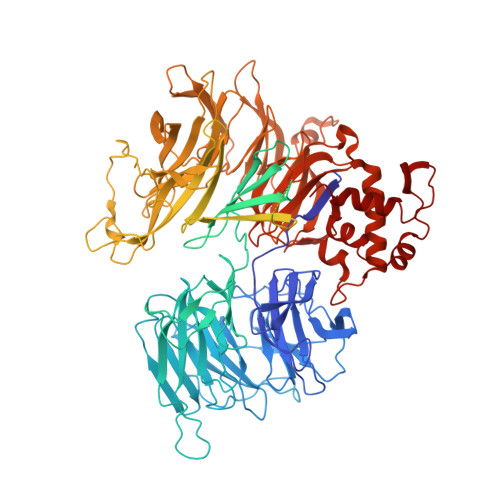Mechanistic insights into a heterobifunctional degrader-induced PTPN2/N1 complex.
Hao, Q., Rathinaswamy, M.K., Klinge, K.L., Bratkowski, M., Mafi, A., Baumgartner, C.K., Hamel, K.M., Veits, G.K., Jain, R., Catalano, C., Fitzgerald, M., Hird, A.W., Park, E., Vora, H.U., Henderson, J.A., Longenecker, K., Hutchins, C.W., Qiu, W., Scapin, G., Sun, Q., Stoll, V.S., Sun, C., Li, P., Eaton, D., Stokoe, D., Fisher, S.L., Nasveschuk, C.G., Paddock, M., Kort, M.E.(2024) Commun Chem 7: 183-183
- PubMed: 39152201
- DOI: https://doi.org/10.1038/s42004-024-01263-7
- Primary Citation of Related Structures:
8U0H, 8UH6 - PubMed Abstract:
PTPN2 (protein tyrosine phosphatase non-receptor type 2, or TC-PTP) and PTPN1 are attractive immuno-oncology targets, with the deletion of Ptpn1 and Ptpn2 improving response to immunotherapy in disease models. Targeted protein degradation has emerged as a promising approach to drug challenging targets including phosphatases. We developed potent PTPN2/N1 dual heterobifunctional degraders (Cmpd-1 and Cmpd-2) which facilitate efficient complex assembly with E3 ubiquitin ligase CRL4 CRBN , and mediate potent PTPN2/N1 degradation in cells and mice. To provide mechanistic insights into the cooperative complex formation introduced by degraders, we employed a combination of structural approaches. Our crystal structure reveals how PTPN2 is recognized by the tri-substituted thiophene moiety of the degrader. We further determined a high-resolution structure of DDB1-CRBN/Cmpd-1/PTPN2 using single-particle cryo-electron microscopy (cryo-EM). This structure reveals that the degrader induces proximity between CRBN and PTPN2, albeit the large conformational heterogeneity of this ternary complex. The molecular dynamic (MD)-simulations constructed based on the cryo-EM structure exhibited a large rigid body movement of PTPN2 and illustrated the dynamic interactions between PTPN2 and CRBN. Together, our study demonstrates the development of PTPN2/N1 heterobifunctional degraders with potential applications in cancer immunotherapy. Furthermore, the developed structural workflow could help to understand the dynamic nature of degrader-induced cooperative ternary complexes.
Organizational Affiliation:
Calico Life Sciences LLC, South San Francisco, CA, 94080, USA. qhao@calicolabs.com.


















